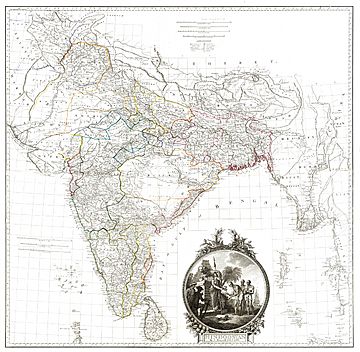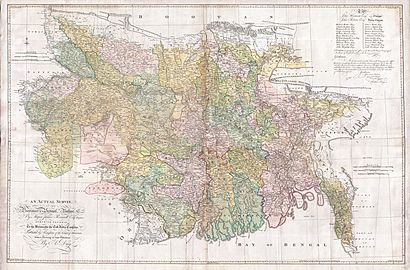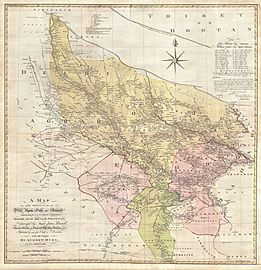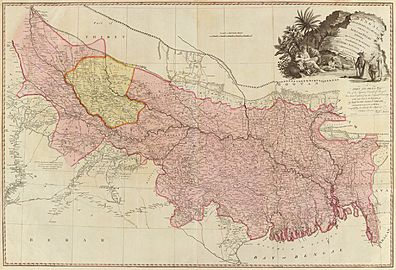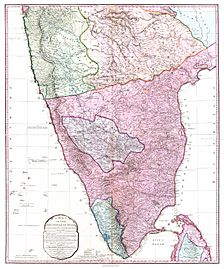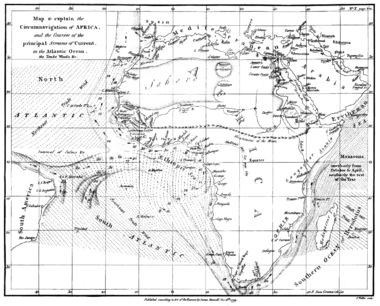James Rennell facts for kids
Quick facts for kids
James Rennel
|
|
|---|---|
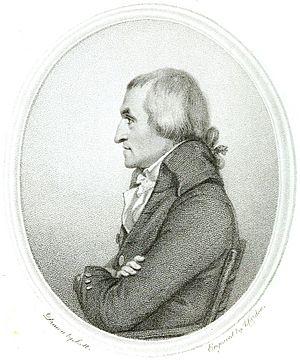
Profile engraving of James Rennell (1799)
|
|
| Born | 3 December 1742 Chudleigh, Devon, UK
|
| Died | 29 March 1830 (aged 87) London
|
| Resting place | Westminster Abbey |
| Occupation |
|
| Employer | East India Company |
| Spouse(s) |
Jane Thackeray
(m. 1772–1810) |
| Parent(s) |
|
| Signature | |
James Rennell (born December 3, 1742 – died March 29, 1830) was an English geographer, historian, and a pioneer in the study of oceans, known as oceanography. He created some of the first accurate maps of Bengal (a region in India) and detailed outlines of India. He was also the Surveyor General of Bengal. People often call Rennell the Father of Oceanography because of his important work. In 1830, he helped start the Royal Geographical Society in London.
Contents
James Rennell was born in a place called Upcot, near Chudleigh in Devon, England. His father, John Rennell, was an officer in the army who died in a war in 1747. James was then raised by a guardian, Reverend Gilbert Burrington.
When he was 14, James joined the Royal Navy as a young officer. He served under Captain Hyde Parker during the Seven Years' War. He was part of some battles and adventures at sea, including a mission in Pondicherry. He quickly became very good at marine surveying, which is about mapping coastlines and sea areas.
Because of his skills, Captain Parker let him work for the British East India Company. He spent a year on one of their ships, exploring new trade routes to the Philippines. He also worked with another mapmaker, Alexander Dalrymple, drawing charts and plans of harbors.
In 1763, after the war ended, Rennell joined the East India Company's sea service. He was given command of a ship, but it was destroyed in a big storm in Madras. Luckily, he was on shore. He was then put in charge of a small yacht called the Neptune. With this yacht, he mapped important waterways like the Palk Strait and the Pamban Channel.
He became good friends with the Governor of Madras, Robert Palk. Later, he arrived in Calcutta (now Kolkata) in Bengal. The governor there wanted to start mapping the British territories. James Rennell was chosen for this important job and became a junior officer in the Bengal Engineers in 1764.
Mapping India: A Challenging Task
Rennell began mapping the Ganges River in 1764. In 1766, he saw the Himalayas for the first time. His main goal was to find a way for ships to travel from Calcutta to the northern parts of the region.
During his work, Captain Rennell faced dangers. In 1766, his survey team was attacked by a group of people near the Bhutan border. He was badly hurt in the shoulder and had to travel for six days by boat to Dacca (now Dhaka) for treatment. He was lucky to recover, but his right arm never fully worked again.
His work was highly valued, and he was given a good salary. He sent money home to his family. In 1767, Lord Robert Clive, who was the Governor of Bengal, made him the Surveyor General of the East India Company's lands in Bengal. After this, Rennell always had soldiers with him for protection.
Rennell's main office was in Dacca. Each year, he worked hard to complete his difficult and often dangerous mapping tasks. Distances were measured using a special wheel called a perambulator, which counted its revolutions. Sometimes, his men were attacked by wild animals, like a leopard. Malaria was also a common illness.
The mapping project started as a general survey of new lands. But under Warren Hastings, who became Governor-General in 1773, the project grew. Hastings wanted to create a detailed record of property, land, and people for tax purposes. Rennell's surveys were like military maps, focusing on safe routes and gathering information.
James Rennell became a major in the Bengal engineers in 1776. He retired from active service in 1777. The government gave him a yearly payment of £600.
He spent the next 53 years of his life in London. He focused on geographical research, using materials from the East India Company's main office. His house became a meeting place for travelers from all over the world.
Major Achievements and Discoveries
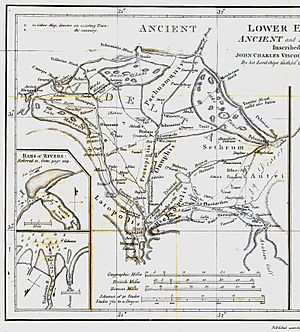
Rennell's most important work was the Bengal Atlas (1779). This was followed by the first detailed map of India (1783). He also wrote books about ancient geography, like Geographical System of Herodotus (1800). He even contributed to books about travels in Africa.
Interestingly, Rennell once added a mountain range called the Mountains of Kong to his maps of West Africa. This was a mistake, and these mountains appeared on maps until the early 1900s. He also wrote papers about places like Babylon and the landing place of Julius Caesar in Britain.
Besides his work on land geography, James Rennell is famous for his studies of ocean currents. He started this research while sailing from India to Britain after he retired in 1777. During a very long journey around the Cape of Good Hope, he mapped the currents near South Africa, which is now called the Agulhas Current. He published this work in 1778. This was one of the first big steps in the science of Oceanography. He was also the first to explain a special current south of the Isles of Scilly, which is now called Rennell's Current.
After his wife died in 1810, he returned to studying oceans. Many of his friends in the navy gave him information from their ship logs. He used this data to create a chart of all the currents in the Atlantic Ocean. His last work, Currents of the Atlantic Ocean, was published after he died by his daughter Jane in 1832.
Rennell was elected a member of the fellow of the Royal Society in 1781. He received the Copley Medal from the Royal Society in 1791, which is a very important award for scientific achievement. He is known as the Father of Indian Geography and the Father of Oceanography.
Later Life and Legacy
In his later years, James Rennell suffered from a condition called gout. In 1829, he fell and broke his thigh bone. He passed away on March 29, 1830, at his home in London. He was buried in Westminster Abbey, a famous church in London where many important people are laid to rest. There is a special tablet and a bronze statue there to remember him.
The year he died, the Royal Geographical Society was founded. His collection of books was given to this society by his family. In 1851, a type of flowering plant from Asia was named Rennellia in his honor.
Personal Life
People described Rennell as a modest and kind person. He was always ready to share his knowledge. His conversations were interesting, and he had a cheerful spirit.
While in Dacca, Rennell met Jane Thackeray (who died in 1810). She was the daughter of Dr. Thomas Thackeray, a headmaster at Harrow School. James and Jane married in 1772. They had two sons, Thomas and William, who both died without children. They also had two daughters named Jane. One daughter, born in 1773, died young and was buried in Dhaka. Another daughter, born in 1777, later married Admiral Sir John Tremayne Rodd. Lady Rodd spent many years publishing her father's maps and updating his main works. She passed away in 1863.
Images for kids


